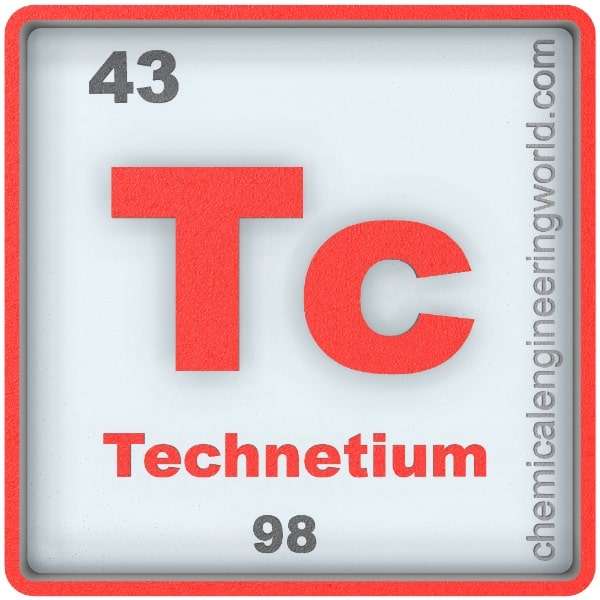Technetium Element Properties and Information

Technetium Element Properties and Information
Technetium is forty-third element on the periodic table. Elements are arranged in the periodic table on the basis of the atomic number. Atomic number is the number of protons in the nucleus of the atom. Technetium has an atomic number of 43. It is located in the Group 7 and Period 5 of the periodic table of elements. It is denoted by Tc. The name is derived from a Greek word ‘Tecknetos’ meaning artificial.
Emilio Segrè discovered technetium in 1937. He subjected molybdenum to high energy radiation and found technetium to be present and separated it.
Technetium is extremely rare in earth’s crust. It is formed during nuclear activity. Naturally, 1 mg of technetium is obtained in a tonne of uranium. Generally it is being obtained from spent nuclear fuel rods.
Physical Properties
- Technetium is a silver gray, crystalline transition metal.
- The atomic mass of technetium is 99
- The melting point of technetium is 2200°C
- The boiling point of technetium is 4877°C
- The density of technetium is 11500 in S.I. units at 20°C
- Technetium is the lightest among all whose isotopes are all radioactive.
- Technetium has only one stable isotope; technetium-97.
- Metallic form of technetium is paramagnetic in nature.
- Pure single-crystal technetium becomes a type-II superconductor below the temperature of 7.46 K.
Chemical Properties
- Metallic technetium gradually tarnishes when exposed to moist air.
- Technetium in powdered form burns in presence of oxygen.
- Technetium is chemically similar to rhenium especially w.r.t chemical inertness and tendency to form covalent bonds.
- Technetium dissolves in concentrated sulphuric acid and nitric acid.
- Technetium does not get dissolved in hydrochloric acid.
- Technetium reacts and forms oxides, selenides, sulphides, tellurides, hydrides, halides, and organometallic complexes.
Methods of Production
- Fission Product: Technetium is produced commercially only by processing the spent nuclear fuel rods. Technetium-99m, a metastable isotope, is produced during reactions of uranium-235 and uranium-238. Molybdenum-99 is also produced. It is left in storage and standstill until the molybdenum-99 gets converted to technetium-99m.
- Neutron Activation: Technetium-99m is produced by neutron activation of molybdenum-99. This molybdenum-99 can be formed by nuclear activation of molybdenum-98. This method allows the control of selectivity of production of various isotopes of technetium.
- Particle Accelerator: Proton is bombarded on molybdenum to produces desired technetium. Cyclotron is used for 22-MeV-proton bombardment on a molybdenum-100 target to produce technetium-99m.
Relevance in Chemical and Related Industries
- Catalyst: Technetium serves a superior catalytic activity in dehydrogenation of isopropyl alcohol than rhenium or palladium catalyst. Radioactivity of technetium is a major industrial problem for safe catalytic operation.
- Corrosion protection: Mild carbon steels can be effectively protected by as little as 55 ppm of potassium pertechnetate (VII) in aerated distilled water even at temperatures of about 250°C. Since it is radioactive in nature the application is limited to confined cases.
Relevance in Other Industries
- Medicine: Foremost use of technetium-99m is for medical testing. Here ‘m’ stands for metastable nuclear isomer. It is suitable for the role because it emits easily detectable gamma rays and its half life is about 6 hours.
- Tracer: The technetium-95m has a half life of about 61 days. It is used as a radioactive tracer to study the movement of tracer in the environment and plant & animal system.
- Standardisation: The technetium-99 being different from technetium-99m decays almost immediately by beta decay process. It does not decay by gamma decay. It has a very long half life hence its emission decreases very slowly with time hence it is used for equipment calibration.
Health Effects on Exposure
Handling: Technetium is found to possess low chemical toxicity as in it does not change the body chemistry much to have any adverse effect but inhalation of dust while working with technetium posses an increase in risk of lung cancer. A fume hood can solve this issue. All the isotopes of technetium are to be handled carefully.
Effects on Surroundings
- Waste: Technetium-99 is environmentally hazardous but since it decays with weak beta emission, even the laboratory glasswares can stop the emission to seep in to the surroundings. The plutonium-uranium extraction leaves a liquid rich in technetium-99 which has to be stored because it cannot be released directly into the surroundings. This is adding to the planetary burden because of accumulating wastes.
References:
https://en.m.wikipedia.org/wiki/Technetium
































